Prof. Mudiyanse Dissanayake
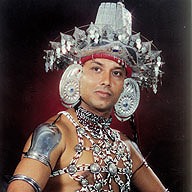 Mudiyanse Dissanayake was born in the mountain country to a family who had inherited the Hill Country classical dancing traditions. He studied dancing at home already as a child. As a young student at the Department of Aesthetic Studies in the University of Kelaniya, he consolidated his knowledge of the performing arts of Sri Lanka. He defended his doctoral thesis on performing arts at the University of Sri Jayawardanapura (Sri Lanka), and after that went on to earn a Diploma in Kathak Dancing from South India. Prof. Mudiyanse Dissanayake is considered as an exponent of the Hill Country Classical Dance of Sri Lanka. During his professorship he has extensively researched the field of dance and tightened the relationships of the classical dancing traditions of India and Sri Lanka. He has traveled foreign shores as well, illustrating, performing, lecturing, entertaining, and inspiring the world with the sacred dancing tradition which he inherited from his forefathers. At present, he works as the Director of the Department of Dancing at the Institute of Aesthetic Studies of the University of Kelaniya.
Mudiyanse Dissanayake was born in the mountain country to a family who had inherited the Hill Country classical dancing traditions. He studied dancing at home already as a child. As a young student at the Department of Aesthetic Studies in the University of Kelaniya, he consolidated his knowledge of the performing arts of Sri Lanka. He defended his doctoral thesis on performing arts at the University of Sri Jayawardanapura (Sri Lanka), and after that went on to earn a Diploma in Kathak Dancing from South India. Prof. Mudiyanse Dissanayake is considered as an exponent of the Hill Country Classical Dance of Sri Lanka. During his professorship he has extensively researched the field of dance and tightened the relationships of the classical dancing traditions of India and Sri Lanka. He has traveled foreign shores as well, illustrating, performing, lecturing, entertaining, and inspiring the world with the sacred dancing tradition which he inherited from his forefathers. At present, he works as the Director of the Department of Dancing at the Institute of Aesthetic Studies of the University of Kelaniya.
Chinthaka Bandara
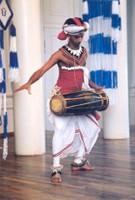 Born in the Hill Country where the classical dancing traditions are deeply rooted, after finishing high school there, Chinthaka Bandara entered the Institute of Aesthetic Studies of the University of Kelaniya to further develop his skills and understanding of the art. The academy soon recognised his extraordinary talent and provided him with the opportunity and scholarship to learn dancing and drumming under the elite masters including Prof Mudiyanse Dissanayake. Chinthaka Bandara has earned his degree in Fine Arts from the university of Kelaniya and is currently attached to the Department of Aesthetic Studies under the guidance of Prof Dissanayake.
Born in the Hill Country where the classical dancing traditions are deeply rooted, after finishing high school there, Chinthaka Bandara entered the Institute of Aesthetic Studies of the University of Kelaniya to further develop his skills and understanding of the art. The academy soon recognised his extraordinary talent and provided him with the opportunity and scholarship to learn dancing and drumming under the elite masters including Prof Mudiyanse Dissanayake. Chinthaka Bandara has earned his degree in Fine Arts from the university of Kelaniya and is currently attached to the Department of Aesthetic Studies under the guidance of Prof Dissanayake.
Navaz Vasi Ahmed Khan
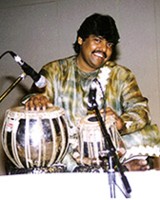 Vasi Ahmed Khan is a talented young artist from the western coast of North India, the Maharashtra. As most of the well-known artists, Vasi Ahmed Khan started his music career when he was about seven under the famous guru Ustad Nawab Ali Khan. Progressing as if he were born for the tabla, little Vasi gave his first solo performance on the All India Radio when he was ten, revealing his incomparable abilities to the whole country. Recognising the young pupil's enthusiasm, talents, and motivation for studying the classical music, Guru Nawab Ali Khan took the young Vasi under his wing, devoting considerable time to special instruction with the hope of producing the future maestro of tabla music. For the next 20 years Vasi Ahmed Khan had to follow painstakingly the lessons and practice of Hindustani classical musical rhythms on the tabla. Today, Navaz Vasi Ahmed Kahn is considered one of the top tabla players in India. He has accompanied a number of famous artists in their instrumental, vocal, or dancing performances. Many times he has traveled the foreign shores, performing Indian classical music with other artists, and has even participated in special projects with American jazz musicians. At present, he has shouldered the responsibility of teaching and training the young students of tabla and proudly carries the honorary title of the teacher as his own guru did.
Vasi Ahmed Khan is a talented young artist from the western coast of North India, the Maharashtra. As most of the well-known artists, Vasi Ahmed Khan started his music career when he was about seven under the famous guru Ustad Nawab Ali Khan. Progressing as if he were born for the tabla, little Vasi gave his first solo performance on the All India Radio when he was ten, revealing his incomparable abilities to the whole country. Recognising the young pupil's enthusiasm, talents, and motivation for studying the classical music, Guru Nawab Ali Khan took the young Vasi under his wing, devoting considerable time to special instruction with the hope of producing the future maestro of tabla music. For the next 20 years Vasi Ahmed Khan had to follow painstakingly the lessons and practice of Hindustani classical musical rhythms on the tabla. Today, Navaz Vasi Ahmed Kahn is considered one of the top tabla players in India. He has accompanied a number of famous artists in their instrumental, vocal, or dancing performances. Many times he has traveled the foreign shores, performing Indian classical music with other artists, and has even participated in special projects with American jazz musicians. At present, he has shouldered the responsibility of teaching and training the young students of tabla and proudly carries the honorary title of the teacher as his own guru did.
Tabla
The name tabla has probably been derived from the Arabic word "tabl" and possibly to some extent from the Turkish word "dawal" meaning ?drum', due to the close ties India had with Persia for many centuries. Over the last two hundred years, tabla has become the most popular percussion instrument in the Indian classical music.Tabla consists of two drums - the masculine drum (bayan) to produce base tones and the feminine drum (dayan) to produce treble tones. The musician has to tune these drums to a certain pitch before the performance. Tabla is played today both as an accompanying instrument and a solo one.
The knowledge of the percussion instruments in India is very old. It is
said that all types of percussion instruments have developed from the huge earth drum called bhumi-dundubhi which was used by the Aryans to give warning of danger. During the gandarva-music period, before the classical period, two the most important books on musicology, Natyashasthra and Nardiyasikasa were written. These contain complete descriptions and teachings of music including also the percussion instruments. During the classical and post-classical period, the drums were given complex designs and were tuned to defined pitches such as Ga, Sa, and Pa. It is believed that tabla developed as a hybrid drum from the existing versatile drums, particularly from the puskara which consisted of two horizontal drums and a vertical one. Tabla finally came into its present-day shape in the 18th century.
Isuru V. Perera
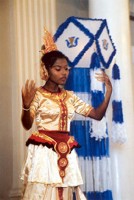 Born in 1980 in Colombo as the daughter of Hemapala Perera, since her childhood she influenced by her father and relatives, all of whom are reputed musicians. She learned singing, music and drama, taking part in many festivals already at a young age. She then spent several was years learning Kathak and the ancient classical dancing styles from South India. Currently she is devoted to Hill Country Classical Dancing under the Guru Prof Mudiyanse Dissanayake.
Born in 1980 in Colombo as the daughter of Hemapala Perera, since her childhood she influenced by her father and relatives, all of whom are reputed musicians. She learned singing, music and drama, taking part in many festivals already at a young age. She then spent several was years learning Kathak and the ancient classical dancing styles from South India. Currently she is devoted to Hill Country Classical Dancing under the Guru Prof Mudiyanse Dissanayake.
Raho Langsepp
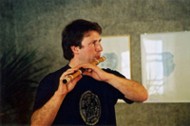 Raho Langsepp started music studies under T. Sepp and continued in Tartu College of Music majoring in flute and oboe. Later has studied privatly under different renown music masters including W. Hazelzet (baroque flute, Holland), R. Fernando (bamboo flute, Sri Lanka) and Guru V. Hemapala Perera (bamboo flute, Sri Lanka). At present he is working as musician, teacher and organizer. He is founder and artistic director of Tartu Early music Festival (being held since 1996) and director of intercultural centre Festivitas Artium. In October 2000 Raho Langsepp was elected as the president of CEFEMA (Central European Festivals of Early Music Association).
Raho Langsepp started music studies under T. Sepp and continued in Tartu College of Music majoring in flute and oboe. Later has studied privatly under different renown music masters including W. Hazelzet (baroque flute, Holland), R. Fernando (bamboo flute, Sri Lanka) and Guru V. Hemapala Perera (bamboo flute, Sri Lanka). At present he is working as musician, teacher and organizer. He is founder and artistic director of Tartu Early music Festival (being held since 1996) and director of intercultural centre Festivitas Artium. In October 2000 Raho Langsepp was elected as the president of CEFEMA (Central European Festivals of Early Music Association).
Dobranotch
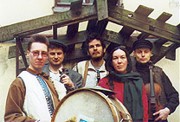 Oleg Dobrinski - clarinet, bagpipes, flutes, gousli, balalaika, vocals
Oleg Dobrinski - clarinet, bagpipes, flutes, gousli, balalaika, vocals Dmitri Hramzov - violin, percussion, vocals
Dmitri Shikhardine - fiddle, gousli, vocals
Natasha Antonova - vocals and percussion
"Dobranotch" was founded in 1997, being formed in France by three Russian musicians from St. Petersburg. As the group comment their style, "at the beginning we played a lot of Celtic music with some medieval repertoire, but now we are more interested in our own cultural heritage." Over time, the group has come to gradually look more to the East. until now when they perform mainly old Russian songs and Balkan music. There were few changes also in the cast. Most of us do not have formal musical education. Our main sources are people we meet, but some books and tapes as well.
The group aims at bringing early music of the Eastern countries (i.e. Slavs and the neighbouring peoples) alive, but doing this in such a way that the young people of our days can resonate with it and understand it. Dobranotch use only acoustic instruments. All the pieces they perform are traditional.
Svara
 Anatolijus Lomonosovas - sitar
Anatolijus Lomonosovas - sitar Vitalijus Logvinovas - tabla, vocals
Eirimas Velicka - zither, vocals
Jurate Adlite - tanpura
Svara is the only group in Lithuania which performs Indian classical music. The group is using authentic musical instruments made in India. Svara means sound in Sanskrit. The group has so far been giving concerts in Russia, Latvia, Estonia and Poland. Its music has been used in soundtracks of such movies as The Ticket to Taj Mahal by the Lithuanian film-maker A. Puipa and The Stone Carver by A. Maciulevicius. The group records its music at the national radio and television facilities; it also collaborates with the Lithuanian National Youth Theater.
Anatolijus Lomonosovas
Anatolijus Lomonosovas, founder of the group, plays sitar since 1981. In 1984 the group gave its first official concert in the House of Composers in Vilnius. In 1985 the group participated in a performance devoted to the outstanding sitar player Ravi Shankar. In 1986, they became a member of the Music Committee of the-then USSR-India society and actively participated in the activities of the Non-European Music Division at the Moscow Conservatory, which was founded by the famous Professor J. K. Mikhailov. During the India-USSR cultural festival, which lasted one year, at the initiative of J. K. Mikhailov A. Lomonosovas was invited to play with Ustad Imrat Khan, one of the most prominent world sitar players, and became his pupil. Lomonosovas was granted scholarships by the Open Society Foundation and the Government of India, and in 1991 and 1997 took professional classes under the guidance of Ustad Imrat Khan in Calcutta. During his stay in India he gave concerts with his teacher and also performed by himself.
Eirimas Velicka
Eirimas Velicka, folk music expert and author of music textbooks has participated in concerts of Svara since 1995. Together with A. Lomonosovas they have also attempted various syntheses of the Indian classical and Lithuanian folk music.
Dr. Hana Blochová
Dr Blochová has studied the piano and the organ (9 years), the recorder and transverse flute (5 years), as well as singing (9 years). She mainly specialises in singing. D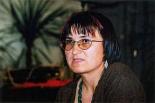 r Blochová is member of several Czech ensembles of early and folk music; since 1993, she has been the Art Director of Kvinterna; since 1992 she has served as Director of the International Early Music Festival held in Cesku Krumlov. Starting 1998 she holds the post of Music Director of the Prague early music club "Mystica"; she also assisted at the foundation of the KA centre (Prague Centre for the Ritual in Music and Arts); in the year 2000, she was appointed Music Director of the Prague Vrtba Baroque Garden cycles of early music concerts.
r Blochová is member of several Czech ensembles of early and folk music; since 1993, she has been the Art Director of Kvinterna; since 1992 she has served as Director of the International Early Music Festival held in Cesku Krumlov. Starting 1998 she holds the post of Music Director of the Prague early music club "Mystica"; she also assisted at the foundation of the KA centre (Prague Centre for the Ritual in Music and Arts); in the year 2000, she was appointed Music Director of the Prague Vrtba Baroque Garden cycles of early music concerts. Arts and sciences
Dr Blochová received her degree from the Natural Sciences Faculty of the Charles University in Prague (1984), specialising in Artefact Conservation and Restoration. She then specialised as a critic (in Music and the Arts) at the J. E. Purkyne Faculty of Philosophy in Brno (1986) and subsequently went on to earn a Master's in Art History, specialising in the Middle Ages, at the same institution (1992). Dr Blochová has worked as Historian of Medieval Arts (Music, Painting, Philosophy and Liturgy) in Prague and the Southern Bohemia. Her main current focus is on Medieval Arts and Philosophy; she is also active as early music singer and musician.
Dr Mustafa Raza
 Dr Mustafa Raza was born in Delhi, in the North Indian region of Madya Pradesh (Central Land) into an honourable family of musicians. Although he was the only boy child in the family, thus linking its past and future, contrarily to the family tradition?his grandfather and father both recognised as outstanding musicians of the country, his first love had been for medicine.
Dr Mustafa Raza was born in Delhi, in the North Indian region of Madya Pradesh (Central Land) into an honourable family of musicians. Although he was the only boy child in the family, thus linking its past and future, contrarily to the family tradition?his grandfather and father both recognised as outstanding musicians of the country, his first love had been for medicine. According to Dr. Raza, accepting his father's request to be the chosen one, he took up music as his career, leaving aside his thoughts of medical degree. This is how today, the vichitra vina music has come to us through the generations. Dr Raza has given his oath to his father, grandfather, and his great-grandfathers to carry this divine art, the vichitra vina music, into the future, thus preserving the tradition. He first started to learn the basics of vina music under his father, later continuing to master the art in the famous music schools in North India.
Today, being a world famous vichitra vina player, he has inspired the public with his music in his homeland as well as in many other countries all over the world. The All India Radio has recognized him as an "A" grade musician, which is the highest ranking in the public broadcasting system for an artist in India. Additionally, he has received countless awards and appreciation from all over the world. Today Dr Raza considers it his mission to popularise his instrument, the vichitra vina, and his tradition of music all over the world.
Vicitra vina
Vichitra vina is a string musical instrument belonging to the Vina family, and is considered one of the oldest musical instruments used in Indian classical music.Although there are many different opinions regarding the origins of vichitra vina, it is highly likely that the prototype of the instrument existed thousands of years ago, as described in Saman Veda.
While some say that the instrument took its present shape already in the 7th century, others believe that the instrument as it is used today was designed as late as in the 17th century. Regardless of those opinions, today, vichitra (colourful, versatile) vina is regarded as one of the oldest instruments found in Indian classical music.
Vichitra vina consists of four main strings and three side strings along with two chikaries (a group of strings which is used for high-pitch tones), and 15 tarabs (sympathetic strings) enabling the musician to play the notes on four octaves.
It is said that vichitra vina is the only plucked instrument which is capable of reproducing the finer nuances of the human vocal apparatus. In Hindustani classical music, vichitra vina is used to play mainly ragas. In the performance it is accompanied by the renowned percussion instrument tabla.
Kvinterna
Music from medieval Bohemia and Spain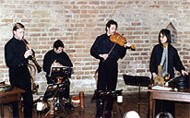 Hana Blochova - vocals, portable organ, recorder
Hana Blochova - vocals, portable organ, recorder Pavel Polasek - bombarde, santouri, shawn, recorder, vocals
Petr Vyoral - treble fiddle, medieval lutes, vocals
Milan Bilek - percussion
One of the main areas of interest of the members of Kvinterna is the Christian and Jewish music of thirteenth and fourtheenth-century Europe. Apart from medieval Spanish songs, such as those of the Cantigas de Santa MarĂa, its repertoire also includes Bohemian church music and music of the Royal Court, particularly of the time of the reign of Emperor Charles IV. Kvinterna is concerned with the reconstruction of Christian rituals and performs music inspired by medieval alchemy. An important part of all its performances consists in improvisation by its members, who also compose and render their own pieces. They use quality copies of the period's instruments as well as various other 'ethnic' instruments. Kvinterna's music often features ornamentation and rhythmic models characteristic of non-European, Oriental influences. Their aim in interpretation is to revive the inspirational multicultural environment of a former age.
The ensemble renewed its activity in 1994 and since that time regularly performs at home and abroad. It takes part in various festivals of ancient and also alternative music. Kvinterna's concerts often have a theatrical quality, reinforcing the music by movement and light. The group also collaborates with radio and television, and recently took part in the making of an American documentary about alchemy in Bohemia.
Discography
Previous recordings by Kvinterna include Dvorská hudba doby Karla IV (Music of the Court from the Time of Charles IV), used in the film Magister Theodoricus, which was part of the identically-named 1998 National Gallery exhibition in Prague, and Rituály stredoveku (Rituals of the Middle Ages), an album containing oracle songs of the Sibyl and songs celebrating the Black Madonna of Montserrat. The following CD to come out, Medieval Inspiration (2000) was an alchemy-related project where Kvinterna members explored musical themes by way of improvisation, working from their collective experience of the interpretation of music as well as from ideas of astrological predestination. The most recent CD, La rosa enflorece (2001) includes the sephardic romances from Spain and the ashkenazi prayers from the Prague archives.



